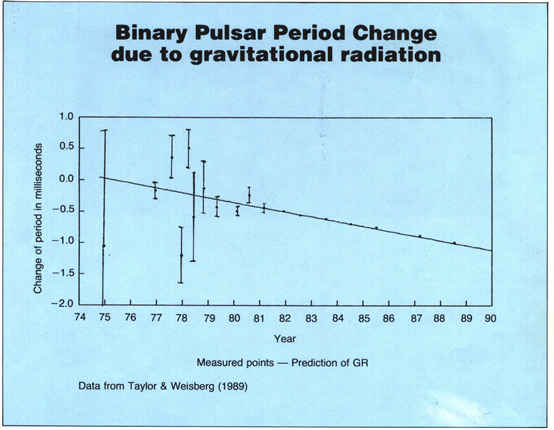
In fact, it is rather easy to understand why such waves exist, by combining two well known pieces of physics. In Newton's theory of gravity, the attractive force between two bodies depends upon their separation, so that when two bodies are moved further apart the force of attraction is less. For centuries it was believed that the change in the force was instantaneous: As soon as you move the bodies further apart, the attractive force weakens. However, Einstein's theory of special relativity changed this view, by stating that no signal can travel faster than light. This means that changes in the gravitational field must propagate away from their source with a velocity equal to or less than that of light. In fact, when the full machinery of general relativity is brought to bear on the problem, one finds that (for weak gravitational fields at least) the changing field propagates with the speed of light. In other words, as soon as one body sees the other body move, it feels the changing gravitational field, and this change in field is communicated by the gravitational waves.
In principle, almost all motions of bodies will produce gravitational waves. However, it turns out that the strongest waves are produced not here on Earth, but instead by violent astrophysical events, such as the explosion of a star or the collision of two black holes. Since the 1960s, experimenters have been developing gravitational wave detectors to observe these waves. A new generation of detectors---the first to have a realistic chance of detecting gravitational waves---are due to start collecting data in the next few years. The first positive detection of a gravitational wave will be a cause of great excitement, providing new experimental evidence supporting general relativity. Even more importantly, by analysing the exact form of the waves, we hope to improve our understanding of the distant astrophysical objects that produce them. In the long run this gravitational-wave astronomy, by probing some of the most extreme objects in the Universe, is likely to profoundly influence our view of Nature.
Although there has been no direct detection of gravitational waves,
there does exist powerful indirect piece of evidence to support their
existence. This concerns a binary neutron star system - two neutron
stars in orbit around their common centre of mass. General relativity predicts
that the gravitational waves emitted by the system carry away energy and angular
momentum. To conserve these quantities, the two stars should slowly spiral in
toward one another, with the orbital motion becoming faster and faster. Such
a spiralling motion was measured by Russell Hulse and Joseph Taylor, for a now
famous binary system known as 1913+16. The rate of inspiral has been found to
match the value predicted by General Relativity to better than 1%. This was
a spectacular success for general relativity, and earned Hulse and Taylor the
1993 Nobel prize.
 |
| The orbital period of a binary millisecond pulsar shows a steady decrease with time. This is due to gravitational waves carrying away energy and angular momentum from the system. In the figure, the vertical error bars represent the observed period, and the straight line the period decrease predicted by General Relativity. From 1982 onwards the error bars are almost too small to be seen, and lie right on top of the predicted spin-down line. |